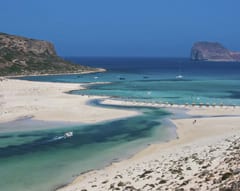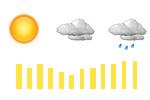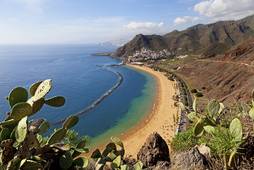Plan an amazing trip to Crete
Crete, the island of the gods, country of myths is a wild and mountainous place. In this part of Europe, the scenery is breathtaking. Despite the sun and the drying winds from Africa, dryness has no effect on the olive groves which extend as far as the eye can see. Above all, Crete’s unspoiled architecture of picturesque villages which brighten the austere hills and which border the sand and pebble beaches. Beaches said to be among the most beautiful in the Mediterranean.

Fabrice's tips, local guide
Best time to go to Crete
Without doubt, spring and autumn are my favourite months:
- The temperature is pleasant and suitable for outdoor activities.
Colours are more vibrant and ideal for photography.
The sea is warm enough for swimming and the beaches are less crowded.
What to see and what to do in Crete
Fabrice answers your most frequently asked questions
By sea : Sail from Venice or Ancona via Igoumenista or Patras. From Patras you have a choice. Either go to Athens, where the crossings are weekly. Or go to Gythion in the southern Peloponnese where the crossings are more ‘exotic’ but less reliable. I advise you to contact the travel agency (there is only one) in advance for tickets. By air : There are numerous regular and low-cost flights (Easyjet, Ryanair) from Athens. Prices vary from £80 to £500 return. Take a look at our flight comparisons to find your flight to Crete.
Various studies have shown the benefits of Cretan cuisine. Cardiovascular problems are lower in Crete where life expectancy is the longest in Europe. So what’s the secret of the Cretan diet? It’s a healthy cuisine based on vegetables, fruit, cereals, fish, a little meat and the high quality local olive oil. There’s the secret to staying healthy. For starter’s there’s Greek Salad - tomatoes, cucumber, peppers, onions and feta, the delicious ewes’s milk cheese. Or there’s tzatziki, a lovely cucumber salad with yoghurt, garlic mint and olive oil. What a treat! Main courses are usually cooked around a base of aubergines, tomatoes and courgettes. Try an authentic moussaka made with aubergines, white sauce and minced meat. Or there’s imam biyaldi, stuffed aubergines, a Turkish dish but known throughout Greece. Lamb, mutton and pork flavoured with herbs are often enjoyed, and fish, grilled or in soups, is also very popular. For dessert, Cretans favour fruit, but you can find very good Middle-Eastern pastries such as baklava and kadaifi. In restaurants, it is very common to be served a glass of raki, an alcoholic aniseed spirit, at the end of your meal.
For me it’s Chania, Hanya and Canea, three names for the same town in the north-west of the island. A melting pot of civilisations have left their mark here (Minoans, Venetians an Ottomans) making Chania a magnificent, exotic and multicultural city. Small backstreets converge on the incessantly lively old port. The blue of the sea contrasts with the multi-coloured house fronts. It’s a place to idly stroll, stop and have a drink or visit a museum. Don’t miss it.
These are the four most visited natural areas of Crete. I think they have reached their capacity in terms of visitor numbers. Of course, they are magnificent, but I would recommend visiting outside the summer season and early in the morning. There is even talk of limiting access to the sites. Walking the gorge Samaria Gorge to Omalos and then the sea talks five or six hours. There are about 600 steps to descend, so mind your knees and use walking poles or even patellar supports if necessary. I recommend to my clients going to Agia Roumeli (there are weekly crossings from Sougia) and to walk up the gorge to the hamlet of Xyloskalo to the iron gate, then walk back. But that’s just my suggestion.
Hiring a car is very easy. Everybody does and there is an enormous fleet. Don’t hesitate to haggle if you are hiring for more than three or four days. If you have booked online and are being met at the airport, be patient. The hirer will arrive. Siga-siga (slowly, slowly) as they say here! Click here to hire a car in Crete .
Travelling by bus is possible. There are connections to take you everywhere. It can be difficult to plan your connections, but with the internet, you should be able to find reliable timetables and you’ll always arrive in the right place eventually.
Both coasts are attractive yet different. However, Malia to the east of Heraklion is an area of large hotel complexes. I love the area around Chania with white mountain peaks in the distance, but I live there so you might expect that. But the south coast has something untamed about it - an energy which is revitalising despite the arid environment. If you are only staying for a fortnight, I urge you to limit your stay to the east or west of the island. You’ll be sure to want to come back.
Finding accommodation is easy, particularly out of season. It seems nearly everyone has a room to let. Learn the Greek phrase “Ehete eleftera thomatia”? - Do you have a room available? Expect to pay from €25 to €150 according to the rating. Take a look at our accommodation page to find a hotels and accommodation in Crete.
It’s a big question, and these are my thoughts:
- Because one feels free here, far from the conventions and pressures of life.
-Because the countryside is accessible with rights of way. Just take care to close the
gates and keep the sheep behind you.
-The cost of living is lower than in the UK.
-The countryside varies from the seaside to mountains. You can climb a mountain or walk
through a ravine in the morning and then visit the beach.
-Good weather is assured from April to October.
-The ubiquitous ruins are a constant reminder that the island has been inhabited for millennia and that we are the heirs of their society.
There are numerous archaeological excavation sites on the island, often Minoan, Venetian or Ottoman. I enjoy the Phaistos Palace in the early hours of the morning as the surroundings are magnificent. The decline of the Minoan society is something which speaks to me. It began following the eruption of the volcano on Santorini which caused a
tidal wave thought to have been more than 40 metres high in places. In one single night, the administrative centres along the coast were destroyed. That was the beginning of the end. The museum in Heraklion is definitely worth a visit. I also like Apta and the ancient port of Falassarna. Of course, there are other major sites to visit.
- Large numbers of tourists during the summer.
-Being able to mix culture with lazing around. -A haven for walkers with hundreds of miles of walking routes. -Exceptional countryside and beautiful beaches. -A pleasant climate. -Cretan food.



























